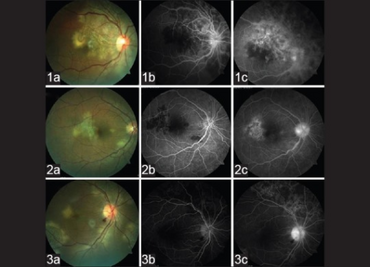Serpiginous choroiditis
| Serpiginous choroiditis | |
|---|---|
| Other names: Geographic helicoid peripapillary choroidopathy | |
 | |
| 1a-3a) Serpiginous choroiditis (fovea involving) 1b-3b) hypofluorescence 1c-3c)shows hyperfluorescence | |
Serpiginous choroiditis, also known as geographic or helicoid choroidopathy, is an uncommon chronic progressive inflammatory disease affecting adult men and women equally in the second to seventh decades of life.[1]
Signs and symptoms
In this condition the posterior uveitis shows a geographic pattern. The inflammation begins in the juxtapapillary choroid and intermittently spreads centrifugally. The overlying retinal pigment epithelium and the outer retina are involved in the inflammatory process.
A closely related condition is multifocal serpiginoid choroiditis. This is caused by tuberculosis.[2]
The distinction between these two conditions is important as the latter responds to anti tuberculosis treatment while the former does not.
Diagnosis
The diagnosis of this condition is done via the following:[3]
- Clinical evaluation
- Electroretinography
- Electro-oculography
- Fluorescein angiography
Treatment
In terms of treatment, none is recommended. should the fovea be affected anti-inflammatory medication can be used[3]
References
- ↑ American academy of Ophthalmology (2012). Basic&Clinical Science Course: Intraocular inflammation and uveitis (2011-2012 last major rev. 2010-2012. ed.). American Academy of Ophthalmology. ISBN 978-1615251162.[page needed]
- ↑ Bansal, Reema; Sharma, Kusum; Gupta, Amod; Sharma, Aman; Singh, Mini P; Gupta, Vishali; Mulkutkar, Samyak; Dogra, Mohit; Dogra, Mangat R; Kamal, Shivali; Sharma, Surya Parkash; Fiorella, Paul D (2015). "Detection of Mycobacterium tuberculosis Genome in Vitreous Fluid of Eyes with Multifocal Serpiginoid Choroiditis". Ophthalmology. 122 (4): 840–50. doi:10.1016/j.ophtha.2014.11.021. PMID 25578256.
- ↑ 3.0 3.1 "Choroiditis, Serpiginous". NORD (National Organization for Rare Disorders). Archived from the original on 21 March 2021. Retrieved 1 February 2022.
External links
| Classification | |
|---|---|
| External resources |